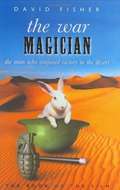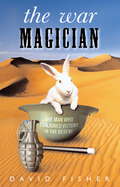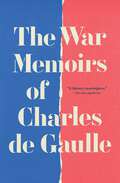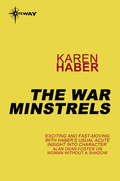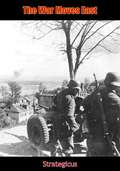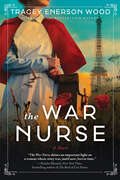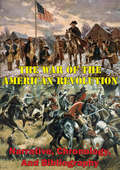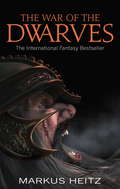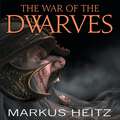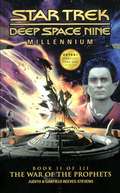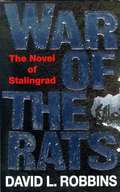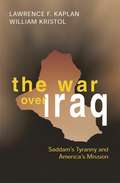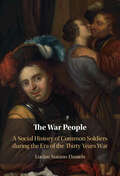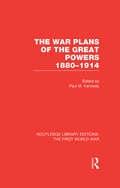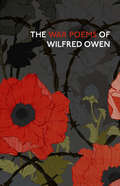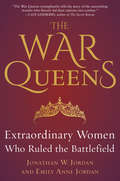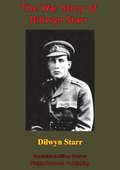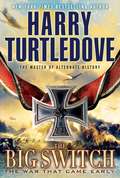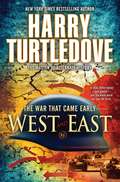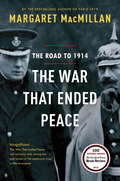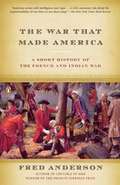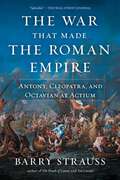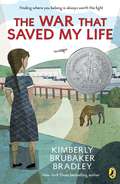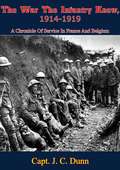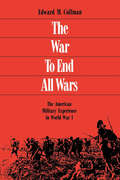- Table View
- List View
The War Magician: The Man Who Conjured Victory In The Desert
by David FisherJasper Maskelyne was a world famous magician and illusionist in the 1930s. When war broke out, he volunteered his services to the British Army and was sent to Eygpt where the desert war had just begun. He used his skills to save the vital port of Alexandria from German bombers and to 'hide' the Suez Canal from them. He invented all sorts of camouflage methods to make trucks look like tanks and vice versa. Working for military intelligence, he put on a stage show inside the Royal Palace in Cairo in order to locate an enemy spy's radio transmitter. On Malta he developed 'the world's first portable holes': fake bomb craters used to fool the Germans into thinking they had hit their targets. His war culminated in the brilliant deception plan that won the Battle of El Alamein: the creation of an entire dummy army in the middle of the desert. Originally published in 1985. British spelling and punctuation is used.
The War Magician: The man who conjured victory in the desert
by David FisherThe incredible true story of the greatest illusionist of modern times and the man who altered the course of the second world war.Soon to be a major film starring Benedict CumberbatchPerfect for fans of OPERATION MINCEMEATJasper Maskelyne was a world famous magician and illusionist in the 1930s. When war broke out, he volunteered his services to the British Army and was sent to Egypt where the desert war had just begun. Here, he used his unique skills to save the vital port of Alexandria from German bombers and to 'hide' the Suez Canal from them. He invented all sorts of camouflage methods to make trucks look like tanks and vice versa. On Malta he developed 'the world's first portable holes': fake bomb craters used to fool the Germans into thinking they had hit their targets. His war culminated in the brilliant deception plan that won the Battle of El Alamein: the creation of an entire dummy army in the middle of the desert.
The War Memoirs
by Charles de GaulleThe complete war memoirs of the resistance leader Charles de Gaulle, who led France out of its darkest hour during the Nazi occupation during World War II.&“Faced with the political disaster, I had to become France.&” This was how Charles de Gaulle answered the call of history. One of the few French battlefield leaders to have distinguished himself in May 1940, he had become the undersecretary of state for national defense. But when the government rejected his calls to fight on and prepared to capitulate to Hitler, he escaped to London. There he instigated a resistance calling on &“all the French who want to remain free to listen to me and follow me&” in the legendary radio address of June 22. He was sentenced to death in absentia as his country made a disgraceful peace, but his Free France movement rallied people around the world to resist German occupation and fight for the liberation of Europe. Originally published in three volumes, The War Memoirs of Charles de Gaulle is the story of the resurrection of France from its darkest hour collaborating with Hitler and the Nazi empire. The first section, &“The Call,&” examines the years leading up to France&’s defeat and the confusion and despair triggered by Hitler&’s blitzkrieg. The second section, &“Unity,&” describes de Gaulle&’s struggles to rally the French in both Africa and underground movements throughout Europe, and often bitter conflicts with the Allied leaders as he sought legitimacy and resources. &“Salvation,&” the final installment, chronicles the turning of the tide of war against Nazi Germany, de Gaulle&’s triumphant return to France, and the reincarnation of the French Republic as a major international presence. De Gaulle&’s great prophecy of 1940 had been fulfilled: France had lost a battle, but she did not lose the war.
The War Minstrels
by Karen HaberKate N. Shadow was the name empath Kayla John Reed took when she was forced to flee her home planet and join the crew of the Falstaff, a "merchant" spaceship that stretched the limits of legal shipping beyond the breaking point. But even the Falstaff could not remain a haven for much longer, not when the forces of magnate Pelleas Karlson and empathy Yates Keller were out to put an end to all the Free Traders who currently plied the spaceways.Kate had nearly fallen victim to the Groupmind controlled by Yates in her last devastating encounter with this ruthless enemy. And with her own empathic talents greatly weakened as a result, she knew that she would need to draw on resources far beyond her own to help the rebel troops known as the War Minstrels in their bid to break Karlson's control of the spaceways. Kate's only hope lay in finding the Mindstar, a mindstone of legendary proportions which could give its successful wielder infinite power - or suck the very life out of anyone who tried to master it and failed...
The War Moves East
by StrategicusVeteran journalist and military commentator “Strategicus” continues his contemporaneous history of the Second World War in “The War Moves East”. Starting with the German offensive against Kiev and Leningrad the book follows the most successful period of the Wehrmacht in the East up to their final repulse before Moscow. In the deserts of Africa Rommel drives his Afrika Korps forward and in the Far East the Japanese run amok against American, Chinese and British Forces. The author ties all of these threads together in a highly readable volume that still stands up as very accurate history.
The War Nurse: A Novel
by Tracey Enerson Wood"Any readers who enjoyed the mix of romance, intrigue, and medical accuracy of Call the Midwife will love The War Nurse."—New York Journal of Books"[An] impeccably researched, well-drawn, based-on-a-true-story tale, written by a former RN...The War Nurse shines an important light on a woman whose story was, until now, lost to time."—Kristin Harmel, New York Times bestselling author of The Book of Lost NamesBased on a true story, The War Nurse is a sweeping historical novel by USA Today bestselling author Tracey Enerson Wood that takes readers on an unforgettable journey through WWI France.She asked dozens of young women to lay their lives on the line during the Great War. Can she protect them?Superintendent of Nurses Julia Stimson must recruit sixty-four nurses to relieve the battle-worn British, months before American troops are ready to be deployed. She knows that the young nurses serving near the front lines will face a challenging situation, but nothing could have prepared her for the chaos that awaits when they arrive at British Base Hospital 12 in Rouen, France. The primitive conditions, a convoluted, ineffective system, and horrific battle wounds are enough to discourage the most hardened nurses, and Julia can do nothing but lead by example—even as the military doctors undermine her authority and make her question her very place in the hospital tent.When trainloads of soldiers stricken by a mysterious respiratory illness arrive one after the other, overwhelming the hospital's limited resources, and threatening the health of her staff, Julia faces an unthinkable choice—to step outside the bounds of her profession and risk the career she has fought so hard for, or to watch the people she cares for most die in her arms.Fans of Martha Hall Kelly's Lost Roses and Marie Benedict's Lady Clementine will devour this mesmerizing celebration of some of the most overlooked heroes in history: the fierce, determined, and brave nurses who treated soldiers in World War I.Praise for The War Nurse:"Through careful research, this book shows the incredible bravery and compassion of women who find themselves in extraordinary situations."—Julia Kelly, international bestselling author of The Last Garden in England and The Light Over London"A rich, gripping history of one woman's lifelong battle against systemic prejudice."—Stewart O'Nan, award-winning author of The Good Wife"Once again, Tracey Enerson Wood, with her impeccable research and evocative prose, kept me glued to the page. Wood has a talent for bringing strong, yet lesser-known women from history, to life."—Linda Rosen, author of The Disharmony of Silence"A riveting and surprisingly timely story of courage, sacrifice, and friendship forged at the front lines."—Kelly Mustian, author of The Girls in the Stilt House"If you, like me, are a voyeur of historical drama that unfolds as if the kitchen window flew open and the characters were caught in action, then The War Nurse is for you."—Diane Dewey, author of Fixing the Fates"Fans of Patricia Harman will love Wood's treatment of medical expertise in a historical setting."—Booklist
The War Of The American Revolution: Narrative, Chronology, And Bibliography [Illustrated Edition]
by Robert W. CoakleyIncludes over 20 maps and illustrationsThe American Revolution, the Bicentennial of which we are celebrating in 1975 and 1976, was an event of utmost significance in the history of both this country and the world. It brought into being a nation, dedicated to the ideals of liberty and justice, that was destined to become, in less than two centuries, the leader of the western world. And it marked the beginning of vast changes that would sweep that western world in the century following, thrusting aside old monarchical institutions in favor of representative government and free economic institutions. Albeit fought on the battlefields much like other eighteenth century wars, it also carried within it the seeds of change in the military sphere that were to sprout and grow in the French Revolution less than two decades later. It was, in this sense, a war of transition between the epoch of limited wars fought by professional armies and people's wars fought by the "nation in arms."Our first national army, the Continental Army, was created to fight the Revolution. As the forebear of the United States Army of today, the Continental Army established many of the traditions and practices still honored in our service. The War of the American Revolution was, until Vietnam at least, the Army's longest war. It is altogether fitting and proper then that the United States Army should pay particular attention to the study of its origins during the bicentennial years and commemorate the events of the Revolution in which the Continental Army and its adjunct, the militia, participated.The purpose of this small volume is to provide a ready reference for such study and observance. The American Revolution has been intensively studied and written about in the two hundred years that have elapsed since 1775. There is much good scholarship as well as popular writing, both old and new, covering all aspects of the conflict and the political and social changes that accompanied it.
The War Of The Dwarves: Book 2 (Dwarves #2)
by Markus HeitzThe dwarves have gone to battle and they have been victorious. But outside the realm, dark forces are working . . .A secret army of Orcs, made immortal by the hidden powers of the Black Water, now marches towards Girdlegard, set to unleash its fury upon the kingdom. Sooner than they realise, Tungdil and his comrades will need to summon all their courage to do battle against this bloodthirsty horde.The Orcs are not the only threat. An unspeakable new power is growing and threatens the very existence of the dwarves. But both enemies have forgotten one very important truth: a dwarf is never more dangerous than when total obliteration seems inevitable . . .The international bestselling fantasy epic continues.Other books by Markus Heitz:The DwarvesThe Revenge of the DwarvesThe Fate of the DwarvesThe Triumph of the DwarvesRighteous FuryDevastating HateDark PathsRaging StormAera book's one to ten
The War Of The Dwarves: Book 2 (Dwarves #2)
by Markus HeitzThe dwarves have gone to battle and they have been victorious. But outside the realm, dark forces are working . . .A secret army of Orcs, made immortal by the hidden powers of the Black Water, now marches towards Girdlegard, set to unleash its fury upon the kingdom. Sooner than they realise, Tungdil and his comrades will need to summon all their courage to do battle against this bloodthirsty horde.The Orcs are not the only threat. An unspeakable new power is growing and threatens the very existence of the dwarves. But both enemies have forgotten one very important truth: a dwarf is never more dangerous than when total obliteration seems inevitable . . .The international bestselling fantasy epic continues.Other books by Markus Heitz:The DwarvesThe Revenge of the DwarvesThe Fate of the DwarvesThe Triumph of the DwarvesRighteous FuryDevastating HateDark PathsRaging StormAera book's one to ten
The War Of The Prophets: Millennium #2 (Star Trek: Deep Space Nine #Vol. 2)
by Judith Reeves-StevensContinuing the Star Trek: Deep Space Nine saga—an original novel from New York Times bestselling author Judith Reeves-Stevens!In the last days of the twenty-fourth century, caught in the crossfire of the apocalyptic confrontation between the Bajoran Prophets and the Pah-wraiths, Captain Benjamin Sisko, and his crew face what might be the final millennium. On one side, the Pah-wraiths&’ new Emissary—Kai Weyoun—promises his followers that when Bajor&’s two Celestial -Temples are restored as one, all beings in the universe will ascend to a new and glorious existence with the True Prophets. On the other side, the scientists of Starfleet predict that when the two Bajoran wormholes merge, they will create a Warp 10 shock wave of infinite destructive power. With the Federation on the brink of collapse, and Starfleet consumed by Admiral Jean-Luc Picard&’s obsessive quest to build the largest starship ever conceived, Sisko enters the ultimate race against time for the biggest stakes of all—the survival of the universe itself.
The War Of The Rats
by David L. Robbins'White-knuckle tension as the two most dangerous snipers in Europe hunt each other through the hell of Stalingrad. Immensely exciting and terribly authentic' Frederick ForsythStalingrad in 1942 is a city in ruins, its Russian defenders fighting to the last man to repel the invading German army. One of their most potent weapons is the crack sniper school developed by Vasily Zaitsev. Its members can pick off the enemy at long range, and their daring tactics - hiding for hours in no man's land until a brief opportunity presents itself - mean that no German, and particularly no German officer, can ever feel safe. This part of the battle is as much psychological as anything, and to counter the continuing threat to German morale, the Nazi command bring to the city their own top marksman, Heinz Thorvald. His mission is simple: to identify, and kill, Zaitsev.Based on a true story, THE WAR OF THE RATS is a brilliantly compelling thriller which brings vividly to life probably the most harrowing battlefront of the Second World War.
The War Over Iraq: Saddam's Tyranny and America's Mission
by Lawrence F. Kaplan William CristolThe importance of how we act.
The War People: A Social History of Common Soldiers during the Era of the Thirty Years War
by Lucian Staiano-DanielsThis book uses the transnational story of a single regiment to examine how ordinary soldiers, military women, and officers negotiated their lives within the chaos and uncertainty of the seventeenth century. Raised in Saxony by Wolf von Mansfeld in spring 1625 in the service of the King of Spain, the Mansfeld Regiment fought for one and a half years in northern Italy before collapsing, leaving behind a trail of dead civilians, murder, internal lawsuits…and copious amounts of paperwork. Their story reveals the intricate social world of seventeenth-century mercenaries and how this influenced how they lived and fought. Through this rich microhistorical case study, Lucian Staiano-Daniels sheds new light on key seventeenth-century developments like the military revolution and the fiscal-military state, which is supported by statistical analysis drawn from hundreds of records from the Thirty Years War. This pathbreaking book unifies the study of war and conflict with social history.
The War Plans of the Great Powers: 1880-1914 (Routledge Library Editions: The First World War)
by Paul M. KennedyThe origins of the First World War remain one of the greatest twentieth century historical controversies. In this debate the role of military planning in particular and of militarism in general, are a key focus of attention. Did the military wrest control from the civilians? Were the leaders of Europe eager for a conflict? What military commitments were made between the various alliance blocks? These questions are examined in detail here in eleven essays by distinguished historians and the editor’s introduction provides a focus and draws out the comparative approach to the history of military policies and war plans of the great powers.
The War Poems Of Wilfred Owen
by Wilfred Owen'Orpheus, the pagan saint of poets, went through hell and came back singing. In twentieth-century mythology, the singer wears a steel helmet and makes his descent "down some profound dull tunnel" in the stinking mud of the Western Front. For most readers of English poetry, the face under that helmet is that of Wilfred Owen.' Professor Jon Stallworthy, from his Introduction.When Wilfred Owen was killed in the days before the Armistice in 1918, he left behind a shattering, truthful and indelible record of a soldier's experience of the First World War. His greatest war poetry has been collected, edited and introduced here by Professor Jon Stallworthy. This special edition is published to commemorate the end of the hellish war that Owen, though the hard-won truth and terrible beauty of his poetry, has taught us never to forget.
The War Queens: Extraordinary Women Who Ruled the Battlefield
by Jonathan W. Jordan Emily Anne JordanRecently adapted into the War Queens podcast hosted by authors Emily and Jon Jordan, featuring Game of Thrones star Nathalie Emmanuel. Now available on Apple, Spotify, Audible, and all major listening platforms.&“Masterfully captures the largely forgotten saga of warrior queens through the ages . . . an epic filled with victory, defeat, and legendary women.&” —Patrick K. O&’Donnell, bestselling author of The Indispensables History&’s killer queens come in all colors, ages, and leadership styles. Elizabeth Tudor and Golda Meir played the roles of high-stakes gamblers who studied maps with an unblinking, calculating eye. Angola&’s Queen Njinga was willing to shed (and occasionally drink) blood to establish a stable kingdom in an Africa ravaged by the slave trade. Caterina Sforza defended her Italian holdings with cannon and scimitar, and Indira Gandhi launched a war to solve a refugee crisis. From ancient Persia to modern-day Britain, the daunting thresholds these exceptional women had to cross—and the clever, sometimes violent ways in which they smashed obstacles in their paths—are evoked in vivid detail. The narrative sidles up to these war queens in the most dire, tumultuous moments of their reigns and examines the brilliant methods and maneuvers they each used to defend themselves and their people from enemy forces. Father-daughter duo Jonathan W. and Emily Anne Jordan extoll the extraordinary power and potential of women in history who walked through war&’s kiln and emerged from the other side—some burnished to greatness, others burned to cinders. All of them, legends. &“Reminds us intelligently, entertainingly and powerfully that strong-willed women have always been the equal—and very often the superior—of their male counterparts, even in the field historically most jealously reserved for men: warfare.&” —Andrew Roberts, New York Times–bestselling author &“This book should be required reading for anyone who loves history.&” —James M. Scott, Pulitzer Prize finalist
The War Story Of Dillwyn Parrish Starr
by Louis Starr Dillwyn Parrish StarrDillwyn Parrish Starr led a short life but he lived it at a tremendous speed, when the First World War broke out he was a star American Football Player and scholar at Harvard. However spurred on by his convictions he sailed to the U.K. in a rush and signed up for service as soon as possible; thereafter he saw a great deal of fighting with the Royal Navy Armored car detachment. However as the war stagnated to the static bloody fighting in the trenches he felt compelled to transfer to the prestigious Grenadier Guards in the British Army. Always heavily engaged Dillwyn fought with great courage in both Flanders and on the Gallipoli campaign, before falling to the overwhelming fire of the Germans at Ginchy during the infernal Somme battle in 1916. His letters are a vivid memento to a man who was universally respected even in a regiment with such high standards as the Grenadiers Guards, cheerful and upbeat snuffed out too soon in the hell of World War One.
The War That Came Early: The Big Switch (The War That Came Early #3)
by Harry TurtledoveIn this extraordinary World War II alternate history, master storyteller Harry Turtledove begins with a big switch: what if Neville Chamberlain, instead of appeasing Hitler, had stood up to him in 1938? Enraged, Hitler reacts by lashing out at the West, promising his soldiers that they will reach Paris by the new year. They don't. Three years later, his genocidal apparatus not fully in place, Hitler has barely survived a coup, while Jews cling to survival. But England and France wonder whether the war is still worthwhile.Weaving together a cast of characters that ranges from a brawling American fighter in the Abraham Lincoln Brigade in Spain to a woman who has seen Hitler's evil face-to-face, Harry Turtledove takes us into a world shaping up very differently in 1941. The Germans and their Polish allies have slammed into the gut of the Soviet Union in the west, while Japan pummels away in the east. In trench warfare in France, French and Czech fighters are outmanned but not outfought by their Nazi enemy. Then the stalemate is shattered. In England, Winston Churchill dies in an apparent accident, and the gray men who walk behind his funeral cortege wonder who their real enemy is. The USSR, fighting for its life, makes peace with Japan--and Japan's war with America is about to begin.A sweeping saga of human passions, foolishness, and courage, of families and lovers and soldiers by choice and by chance, The Big Switch is a provocative, gripping, and utterly convincing work of alternate history at its best. For history buffs and fans of big, blood-and-guts fiction, Harry Turtledove delivers a panoramic clash of ideals as powerful as armies themselves.From the Hardcover edition.
The War That Came Early: West and East (The War That Came Early #2)
by Harry TurtledoveIn 1938, two men held history in their hands. One was Adolf Hitler. The other was British prime minister Neville Chamberlain, who, determined to avoid war at any cost, came to be known as "the great appeaser." But Harry Turtledove, the unrivaled master of alternate history, has launched a gripping saga that springboards from a different fateful act: What if Chamberlain had stood up to Hitler? What would the Nazis' next move have been? And how would the war--which Hitler had always regretted waiting eleven months to start--have unfolded and changed our world?Here, Turtledove takes us across a panorama of conflict fueled by ideology and demagoguery. Nations are pitted against nations, alliances are forged between old enemies, ordinary men and women are hurled into extraordinary life-and-death situations. In Japanese-controlled Singapore, an American marine falls in love with a Russian dance hall hostess, while around him are heard the first explosions of Chinese guerilla resistance. On the frontlines of war-ravaged rural France, a weary soldier perfects the art of using an enormous anti-tank gun as a sniper's tool--while from Germany a killer is sent to hunt him down. And in the icy North Atlantic, a U-boat bearing an experimental device wreaks havoc on British shipping, setting the stage for a Nazi ground invasion of Denmark. From an American woman trapped in Germany who receives safe passage from Hitler himself to a Jewish family steeped in German culture and facing the hatred rising around them, from Japanese soldiers on the remote edge of Siberia to American volunteers in Spain, West and East is the story of a world held hostage by tyrants--Stalin, Hitler, Sanjuro--each holding on to power through lies and terror even in the face of treacherous plots from within.As armies clash, and as the brave, foolish, and true believers choose sides, new weapons are added to already deadly arsenals and new strategies are plotted to break a growing stalemate. But one question looms over the conflict from West to East: What will it take to bring America into this war? From the Hardcover edition.
The War That Ended Peace: The Road to 1914
by Margaret MacmillanFrom the bestselling and award-winning author of Paris 1919 comes a masterpiece of narrative nonfiction, a fascinating portrait of Europe from 1900 up to the outbreak of World War I. The century since the end of the Napoleonic wars had been the most peaceful era Europe had known since the fall of the Roman Empire. In the first years of the twentieth century, Europe believed it was marching to a golden, happy, and prosperous future. But instead, complex personalities and rivalries, colonialism and ethnic nationalisms, and shifting alliances helped to bring about the failure of the long peace and the outbreak of a war that transformed Europe and the world. The War That Ended Peace brings vividly to life the military leaders, politicians, diplomats, bankers, and the extended, interrelated family of crowned heads across Europe who failed to stop the descent into war: in Germany, the mercurial Kaiser Wilhelm II and the chief of the German general staff, Von Moltke the Younger; in Austria-Hungary, Emperor Franz Joseph, a man who tried, through sheer hard work, to stave off the coming chaos in his empire; in Russia, Tsar Nicholas II and his wife; in Britain, King Edward VII, Prime Minister Herbert Asquith, and British admiral Jacky Fisher, the fierce advocate of naval reform who entered into the arms race with Germany that pushed the continent toward confrontation on land and sea. There are the would-be peacemakers as well, among them prophets of the horrors of future wars whose warnings went unheeded: Alfred Nobel, who donated his fortune to the cause of international understanding, and Bertha von Suttner, a writer and activist who was the first woman awarded Nobel's new Peace Prize. Here too we meet the urbane and cosmopolitan Count Harry Kessler, who noticed many of the early signs that something was stirring in Europe; the young Winston Churchill, then First Lord of the Admiralty and a rising figure in British politics; Madame Caillaux, who shot a man who might have been a force for peace; and more. With indelible portraits, MacMillan shows how the fateful decisions of a few powerful people changed the course of history. Taut, suspenseful, and impossible to put down, The War That Ended Peace is also a wise cautionary reminder of how wars happen in spite of the near-universal desire to keep the peace. Destined to become a classic in the tradition of Barbara Tuchman's The Guns of August, The War That Ended Peace enriches our understanding of one of the defining periods and events of the twentieth century.
The War That Made America: A Short History of the French and Indian War
by Fred AndersonThe globe's first true world war comes vividly to life in this "rich, cautionary tale" (The New York Times Book Review) The French and Indian War -the North American phase of a far larger conflagration, the Seven Years' War-remains one of the most important, and yet misunderstood, episodes in American history. Fred Anderson takes readers on a remarkable journey through the vast conflict that, between 1755 and 1763, destroyed the French Empire in North America, overturned the balance of power on two continents, undermined the ability of Indian nations to determine their destinies, and lit the "long fuse" of the American Revolution. Beautifully illustrated and recounted by an expert storyteller, The War That Made America is required reading for anyone interested in the ways in which war has shaped the history of America and its peoples.
The War That Made the Roman Empire: Antony, Cleopatra, and Octavian at Actium
by Barry StraussA &“splendid&” (The Wall Street Journal) account of one of history&’s most important and yet little-known wars, the campaign culminating in the Battle of Actium in 31 BC, whose outcome determined the future of the Roman Empire.Following Caesar&’s assassination and Mark Antony&’s defeat of the conspirators who killed Caesar, two powerful men remained in Rome—Antony and Caesar&’s chosen heir, young Octavian, the future Augustus. When Antony fell in love with the most powerful woman in the world, Egypt&’s ruler Cleopatra, and thwarted Octavian&’s ambition to rule the empire, another civil war broke out. In 31 BC one of the largest naval battles in the ancient world took place—more than 600 ships, almost 200,000 men, and one woman—the Battle of Actium. Octavian prevailed over Antony and Cleopatra, who subsequently killed themselves. The Battle of Actium had great consequences for the empire. Had Antony and Cleopatra won, the empire&’s capital might have moved from Rome to Alexandria, Cleopatra&’s capital, and Latin might have become the empire&’s second language after Greek, which was spoken throughout the eastern Mediterranean, including Egypt. In this &“superbly recounted&” (The National Review) history, Barry Strauss, ancient history authority, describes this consequential battle with the drama and expertise that it deserves. The War That Made the Roman Empire is essential history that features three of the greatest figures of the ancient world.
The War That Saved My Life
by Kimberly Brubaker BradleyTen-year-old Ada has never left her one-room apartment. Her mother is too humiliated by Ada's twisted foot to let her outside. So when her little brother Jamie is shipped out of London to escape the war, Ada doesn't waste a minute--she sneaks out to join him. So begins a new adventure for Ada, and for Susan Smith, the woman who is forced to take the two kids in. As Ada teaches herself to ride a pony, learns to read, and watches for German spies, she begins to trust Susan--and Susan begins to love Ada and Jamie. But in the end, will their bond be enough to hold them together through wartime? Or will Ada and her brother fall back into the cruel hands of their mother?
The War The Infantry Knew, 1914-1919: A Chronicle Of Service In France And Belgium
by Capt. J. C. DunnMemoirs of British medical officer J. C. Dunn during World War I: "The first duty of a battalion medical officer in War is to discourage the evasion of duty...not seldom against one's better feelings, sometimes to the temporary hurt of the individual, but justice to all other men as well as discipline demands it.""Sometimes, through word of mouth and shared enthusiasm, a secret book becomes famous. The War the Infantry Knew is one of them. Published privately in a limited edition of five hundred copies in 1938, it gained a reputation as an outstanding account of an infantry battalion's experience on the Western Front."--Daily Telegraph"I have been waiting for a long time for someone to republish this classic. It is one of the most interesting and revealing books of its type and is a genuinely truthful and fascinating picture of the war as it was for the infantry"--John Keegan'A remarkably coherent narrative of the battalion's experiences in diary form...a moving historical record which deserves to be added to the select list of outstanding accounts of the First World War"--Times Literary Supplement"A magnificent tour de force, the length of three ordinary books."--London Review of Books
The War To End All Wars: The American Military Experience in World War I
by Edward M. CoffmanA comprehensive history of the US military’s involvement in World War I, including soldiers’ experiences, the creation of the air force, and more.The War to End All Wars is considered by many to be the best single account of America’s participation in World War I. Covering famous battles, the birth of the air force, naval engagements, the War Department, and experiences of the troops, this indispensable volume is again available in paperback for students and general readers.Praise for The War to End All Wars“Will surely stand as the first source for anyone interested in the conflict.” —Stephen Ambrose“Coffman’s skilled use of archived materials, diaries and memoirs brings life and immediacy to his story.” —Virginia Quarterly Review“[Coffman] can explain complex matters in a few sharp paragraphs, illuminate technical discussions with personal vignettes, and use statistics to clarify rather than confuse. . . . Should become standard reading in twentieth century American history courses.” —Indiana Magazine of History
